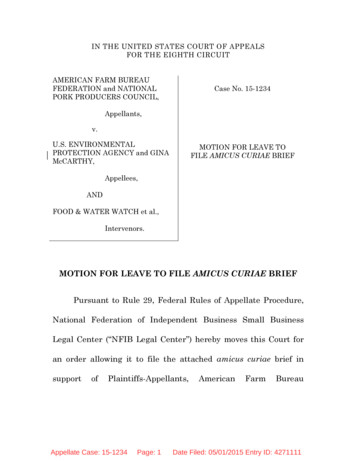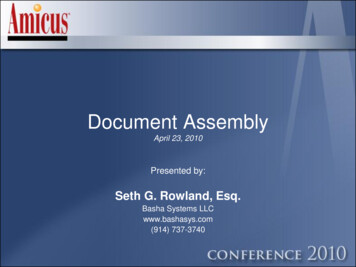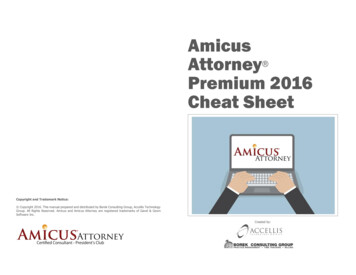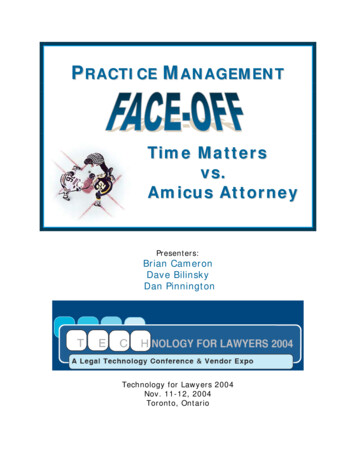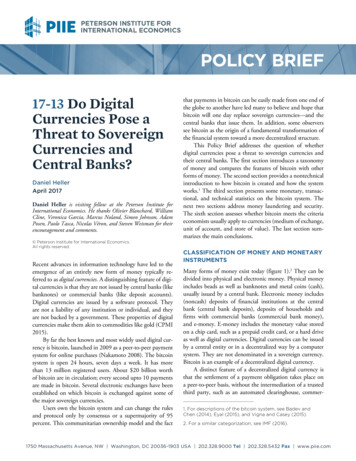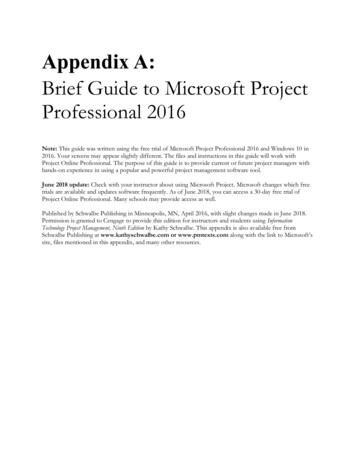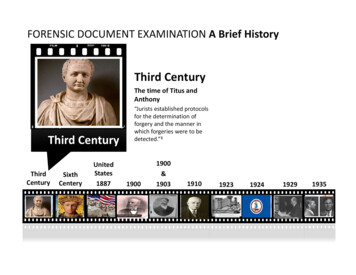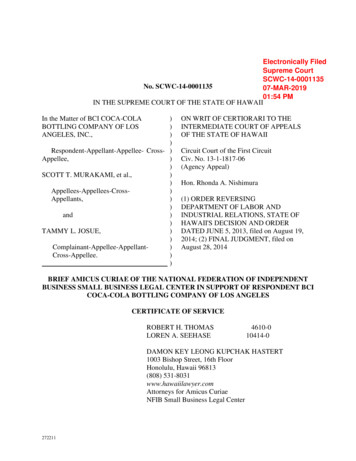
Transcription
Electronically FiledSupreme CourtSCWC-14-0001135No. SCWC-14-000113507-MAR-201901:54 PMIN THE SUPREME COURT OF THE STATE OF HAWAIIIn the Matter of BCI COCA-COLABOTTLING COMPANY OF LOSANGELES, INC.,))))Respondent-Appellant-Appellee- Cross- )Appellee,))SCOTT T. MURAKAMI, et TAMMY L. lee.))ON WRIT OF CERTIORARI TO THEINTERMEDIATE COURT OF APPEALSOF THE STATE OF HAWAIICircuit Court of the First CircuitCiv. No. 13-1-1817-06(Agency Appeal)Hon. Rhonda A. Nishimura(1) ORDER REVERSINGDEPARTMENT OF LABOR ANDINDUSTRIAL RELATIONS, STATE OFHAWAII'S DECISION AND ORDERDATED JUNE 5, 2013, filed on August 19,2014; (2) FINAL JUDGMENT, filed onAugust 28, 2014BRIEF AMICUS CURIAE OF THE NATIONAL FEDERATION OF INDEPENDENTBUSINESS SMALL BUSINESS LEGAL CENTER IN SUPPORT OF RESPONDENT BCICOCA-COLA BOTTLING COMPANY OF LOS ANGELESCERTIFICATE OF SERVICEROBERT H. THOMASLOREN A. SEEHASE4610-010414-0DAMON KEY LEONG KUPCHAK HASTERT1003 Bishop Street, 16th FloorHonolulu, Hawaii 96813(808) 531-8031www.hawaiilawyer.comAttorneys for Amicus CuriaeNFIB Small Business Legal Center272211
TABLE OF CONTENTSPageTable of Authorities . iiIDENTITY AND INTEREST OF AMICUS. . 1SUMMARY OF ARGUMENT . 1ARGUMENT . 3I.The Statute’s Plain Language Allows Employers To Address Staffing Needs,And Does Not Require Them to Accommodate Indefinite Absences . 3II.It Is Impractical To Require Employers To Hold Open Positions Indefinitely . 5CONCLUSION . 10i272211
TABLE OF AUTHORITIESPageCASESBocalbos v. Kapiolani Med. Ctr. for Women & Children, 89 Haw. 436, 974 P.2d 1026 (1999) . 6Burns Int'l Sec. Servs., Inc. v. Dep’t of Transp., 66 Haw. 607, 671 P.2d 446 (1983) . 4Encino Motorcars LLC v. Navarro, 138 S. Ct. 1134 (2018) . 4, 8French v. Hawaii Pizza Hut, Inc., 105 Haw. 462, 99 P.3d 1064 (2004) . 7Gold Coast Neighborhood Ass’n v. State, 140 Haw. 437, 403 P.3d 214 (2017) . 8Heatherly v. Hilton Hawaiian Vill. Joint Venture,78 Haw. 351, 893 P.2d 779 (1995) . 4Lales v. Wholesale Motors Co.,133 Haw. 332, 328 P.3d 341 (2014) . 4Morgan v. Planning, Dep’t, City of Kauai, 104 Haw. 173, 86 P.3d 982 (2004) . 7, 8Parnar v. Americana Hotels, Inc., 65 Haw. 370, 652 P.2d 625 (1982) . 4, 7Phillips v. City of New York, 66 A.D.3d 170, 884 N.Y.S.2d 369 (2009) . 8Shoppe v. Gucci Am., Inc., 94 Haw. 368, 14 P.3d 1049 (2000) . 4, 7Zhang v. State of Hawaii, Dep’t of Land and Nat. Res., No. SCWC-11-0001106,2016 WL 4182511 (Haw. 2016) . 6STATUTESUnited States CodeAmericans With Disabilities Act, 42 U.S.C. §§ 12201-12213 . 3, 7Hawaii Revised Statutes§ 378-32 . passimOTHER AUTHORITIESGuide to Dealing with Independent Contractors, Nat. Fed. of Ind. Bus., . 9ii272211
TABLE OF AUTHORITIES—continuedPageNat’l Fed’n Indep. Bus., Terminating an Employee on Medical Leave? Tread Carefully(May 21, 2018) . 5Tammy La Gorce, As ‘Ban the Box’ Spreads, Private Employers Still Have Questions, N.Y.Times (Nov. 22, 2017) . 2-3Managing the Regulatory Thicket: Cumulative Burdens of State and Local Regulation,Regulatory Transparency Project, Federalist Society . 9NFIB Research Foundation, Small Business Problems & Priorities (Aug. 2016) . 8Testimony of Elizabeth Milito, “Litigation Abuses,”House of Representatives Committee on the JudiciarySubcommittee on the Constitution, March 13, 2013 . 10U.S. Dept. of Labor, Need Time? Employee’s Guide to the Family Medical Leave Act . 6iii272211
BRIEF AMICUS CURIAE OF THE NATIONAL FEDERATION OF INDEPENDENTBUSINESS SMALL BUSINESS LEGAL CENTER IN SUPPORT OF RESPONDENT BCICOCA-COLA BOTTLING COMPANY OF LOS ANGELESAmicus Curiae the National Federation of Independent Business Small Business LegalCenter (NFIB Legal Center) submits the following Amicus Curiae Brief in support of theRespondent BCI Coca-Cola Bottling Co. of Los Angeles, Inc. (BCI).IDENTITY AND INTEREST OF AMICUSThe NFIB Legal Center is a nonprofit, public interest law firm established to providelegal resources and be the voice for small businesses in the nation’s courts through representationon issues of public interest affecting small businesses. The National Federation of IndependentBusiness (NFIB) is the nation’s leading small business association, representing members inWashington, D.C., and all 50 state capitals. Founded in 1943 as a nonprofit, nonpartisanorganization, NFIB’s mission is to promote and protect the right of its members to own, operateand grow their businesses. NFIB represents small businesses nationwide, and its membershipspans the spectrum of business operations, ranging from sole proprietor enterprises to firms withhundreds of employees. While there is no standard definition of a “small business,” the typicalNFIB member employs 10 people and reports gross sales of about 500,000 a year. The NFIBmembership is a reflection of American small business.This case and the issue presented is of great practical importance to Hawaii’s smallbusinesses and NFIB’s members. Amicus filed a brief in the Intermediate Court of Appeals andsought leave to file an amicus brief in the Circuit Court (but that court rendered its judgment infavor of BCI before it ruled on the motion). Managing leave of absence issues is alreadyextremely complicated for small businesses operating without in-house legal counsel or humanresource specialists. As a practical matter, small business owners need the flexibility to hire newemployees when they have lost essential personnel for an extended and indefinite timeframe.SUMMARY OF ARGUMENTThe question presented is whether in Haw. Rev. Stat. § 378-32(a)(2), the legislatureintended to require employers to hold open a long-absent injured worker’s position indefinitely,or whether by prohibiting adverse actions by the employer “solely because the employee hassuffered a work injury,” it meant to preserve employers’ flexibility to hire a replacement as maybe needed to address pressing business demands. The ICA correctly understood that the plainlanguage of the statute preserves the prerogative of an employer to make necessary business272211
decisions about staffing needs, so long as the employer does not “suspend, discharge, ordiscriminate” an employee only because the employee is injured. Id. (quoted in ICA Op. at 6).The circuit court concluded—and the ICA affirmed—that BCI did not discharge Petitioner solelybecause of her injury. BCI needed to fill the position with someone who could handle itscontinued workload because Petitioner’s long absence was causing strain on two otheremployees who had been forced to work longer hours to cover these duties; consequently theposition was no longer open when Petitioner finally informed BCI she was ready to work. Inshort, legitimate business concerns caused BCI to fill the spot permanently, and thus, Petitioner’sinjury was not the sole reason for discharge. Certainly, but for Petitioner’s injury, there was noneed to fill her position. See Cert. App. at 7 (“Stated otherwise, but for that injury, there was noneed to fill her position.”). However, “but for” causation is not the standard established by thestatute’s use of the term “solely.” That statutory term means that an employee’s injury may bepart of the reason for the employer’s actions, but it cannot be the only reason. Here, it was not.The ICA’s reading of the plain statutory text makes sense because it protects injuredemployees from adverse actions only on account of their injury, but also appreciates the practicalrealities that employers face when an essential position is left vacant during a prolonged andindefinite absence. The interpretation advocated by Petitioner effectively deletes the term“solely” from the statute, and would read it as conferring an entitlement for permanentemployment, regardless of how greatly the position’s mounting workload may strain theemployer. This would create extreme practical difficulties for small businesses with limitedresources.The ICA’s conclusion is also consistent with how other state and federal courts applysimilar anti-discrimination statutes, which are construed as requiring only reasonableaccommodations—i.e., so as to avoid imposing undue, and potentially ruinous, burdens on smallemployers. Hawaii’s employers should not be required to create a position that does not alreadyexist for which there is no business necessity, or to maintain an injured employee’s job for anextended and indefinite time when pressing business needs demand that the position be filled(now) with someone who can get the work done.1 Petitioner’s strained reading of the statuteplaces small business employers in an impossible situation.“Time is money, and our members need to be able to [fill vacant positions quickly] . Theyneed to send somebody in there to hang the drywall tomorrow.” Tammy La Gorce, As ‘Ban the1(footnote continued on next page)2272211
ARGUMENTI.The Statute’s Plain Language Allows Employers To Address Staffing Needs, AndDoes Not Require Them to Accommodate Indefinite AbsencesThe plain text of Haw. Rev. Stat. § 378-32(a)(2) provides that an employer may not“suspend, discharge, or discriminate against” an employee “[s]olely because the employee hassuffered a work injury [] unless the employee is no longer capable of performing theemployee’s work and the employer has no other available work which the employee is capableof performing.” Haw. Rev. Stat. § 378-32(a)(2).Thus, when an employee suffers a work-related injury, the plain meaning of the statute isthat the employer is permitted to take action if the injury is not the only reason for doing so. Inother words, if there is some other legitimate business reason supporting the employer’s actions,then it does not matter if the employees’ injury was also a cause. Here, it became clear to BCIthat it was burdening two other employees with additional work for an indefinite time, and itneeded someone to fill the position permanently. Thus, the ICA correctly concluded Petitioner’sinjury was not the “sole” reason for discharge. ICA Op. at 6. The statute also requires theemployer to offer the employee other “available” work if the employee can handle it, arequirement which does not save Petitioner’s argument because the record is clear that there wasno such available position. See id. (“and the employer has no other available work which theemployee is capable of performing”). In sum, the statute imposes a duty on employers to try (ifreasonably feasible) to get an injured employee back to work, preferably in the same positionthey held prior to the injury (if possible). This effectively adopts the reasonable accommodationstandard entailed in the Americans with Disabilities Act and similar anti-discrimination statutes.By contrast, Petitioner advocates for a sweeping and unprecedented new rule: anemployer must hold open a position for an injured employee indefinitely, even if the businessand fellow employees are being unfairly burdened by her long absence and have nounderstanding of when she may return, if ever. See Cert. App. at 6. Petitioner argues she was“temporarily” disabled, and thus BCI could not have a legitimate business reason for filling herposition, regardless of pressing burdens. That amounts to a rule that if an employee is injured, anBox’ Spreads, Private Employers Still Have Questions, N.Y. Times (Nov. 22, small-business-criminal-record.html (last visitedFeb. 12, 2019) (discussing state-based restrictions on the hiring process, and quoting ElizabethMilito, Senior Executive Counsel at NFIB Legal Center).3272211
employer is obligated to hold open her position unless and until such time as the employeebelieves she is “capable of performing.” But the statute imposes no duty on an employer topreserve a position indefinitely merely because an employee has taken a leave of absence due toinjury. The statute requires only that an employer must provide an employee with a position ifshe is capable of performing the work—provided the position is still available.2The common law employment at will doctrine, under which businesses may choose toend the employer-employee relationship for any reason not explicitly prohibited by publicpolicy, informs the ICA’s correct reading of the statute. See Shoppe v. Gucci Am. Inc., 94 Haw.368, 383, 14 P.3d 1049, 1064 (2000). Here the statute sets out an exception to the common lawrule by prohibiting discharge “solely” on account of a workplace injury. But this exceptionshould be limited to the terms that the legislature established, and should not be broadened toimpose additional open-ended burdens on employers, which the legislature did not expresslyinclude. See, e.g., Encino Motorcars LLC v. Navarro, 138 S. Ct. 1134, 1142 (2018) (emphasizingthat employment statutes should be construed strictly in accordance with the statutory text, andaffirming that the “limitations expressed in statutory terms” reflects a legislative “compromise”)(internal citations omitted). Such a radical departure from the common law employment at willbaseline principle cannot be lightly inferred. See Burns Int'l Sec. Servs., Inc. v. Dep’t of Transp.,66 Haw. 607, 611, 671 P.2d 446, 449 (1983) (emphasizing that “statutes which are in derogationof common law must be strictly construed,” and that they should not be construed as abrogatingthe common law in the absence of “express [legislative] intent.”); see also Parnar v. AmericanaHotels Inc., 65 Haw. 370, 380, 652 P.2d 625, 631 (1982) (warning courts to “proceed cautiouslyif called upon to declare [a] public policy [exception to the ‘at will’ doctrine] absent some priorlegislative or judicial expression [that is sufficiently clear] on that subject.”).Whether an employee is “no longer capable of performing the work” must be measured bypresent circumstances, not those in the indefinite future. If the legislature had intended toguarantee an employee an entitlement to maintain a position indefinitely—despite the fact that atpresent she is “no longer capable of performing” the job—it would have used language moreclearly indicating that very sweeping intent. See Lales v. Wholesale Motors Co., SCWC-28516WL 560829 (Haw. Feb. 13, 2014) (rejecting an inference that state law imposes burdens beyondthose required by federal law, and observing that when the Legislature wishes to imposeadditional requirements it knows how to make that intention clear); see e.g., Heatherly v. HiltonHawaiian Vill. Joint Venture, 78 Haw. 351, 356, 893 P.2d 779, 784 (1995) (“We observe thatour state legislature knows how to draft broader definitions” when the legislature intends to givea broader effect than the law would otherwise presume.).24272211
II.It Is Impractical To Require Employers To Hold Open Positions IndefinitelyBCI replaced Petitioner after accommodating her eleven-month absence. This wasentirely reasonable approach under the circumstances, as both the circuit court and the ICAconfirmed, because other employees were forced to cover her workload, which was thenstraining her department.3 Throughout that time, Petitioner was unable to say whether she couldreturn to work anytime soon—or if she would ever return. Still, BCI demonstrated a willingnessto accommodate her as long as it reasonably could. In the end, after nearly a year of trying tomaintain normal operations with a full-time position left vacant—and others covering herworkload—BCI was compelled to find a permanent replacement.Small businesses face this sort of dilemma all the time. In some cases, the employee mayexpress an intent to return, but is waiting on a medical release.4 But all too often the employeehas left with only ambiguous signals as to whether they intend to return, or without anyindication one way or another. In any case, a prolonged and indefinite absence leaves smallemployers in a lurch—straining their daily operations and complicating their prospective plans.A prolonged absence, for even a single employee, is all the more burdensome for acompany operating with a small team and small budget. As NFIB explains in its online guidanceto small business owners nationally: “[a] company might manage without an absent employeefor a short time, [but] the longer the absence—or the more frequent intermittent absencesbecome—the more problematic the issue.” Nat’l Fed’n Indep. Bus., Terminating an Employee onMedical Leave? Tread Carefully (May 21, 2018).5 What is more, managing leave of absence“Between her injury on May 29, 2009 and April of 2010, BCI had two other supervisors coverfor Josue’s absence by learning her position and arriving to work two hours earlier than normalto perform her job in addition to their own duties.” ICA Op. at 13.34In some situations, a doctor cannot give an immediate release because they must see how well(or whether) an injury will heal. But, in other cases a medical release may be delayed because theemployee fails to work proactively with their doctor. Amicus does not suggest that this was thecase here. But in resolving these issues, the Court should be cognizant of the wide range ofscenarios that may prolong an indefinite leave of absence, keeping in mind the practicaldifficulties small business owners face when trying to manage an extended leave of -tread-carefully/ (last visited Feb. 8, 2019).5272211
requests is among the most complicated of issues that small business owners must deal with,often without the benefit of a human resource professional. NFIB’s online guidance notes thatemployers must ensure compliance with the Americans with Disabilities Act, the FamilyMedical Leave Act, state family leave laws, workers compensation laws, employer PTO policies,and other regulatory regimes. Sorting through this morass, NFIB concludes:Individuals unable to return to work after the expiration of legally required or employeroffered leave may be terminated. But an employer must make sure that other forms ofleave and/or statutory protections do not apply. In addition, the employer must evaluatewhether an employee who requests leave because of his or her own serious healthcondition
IDENTITY AND INTEREST OF AMICUS The NFIB Legal Center is a nonprofit, public interest law firm established to provide legal resources and be the voice for small businesses in the nation’s courts through representation on issues of public in
